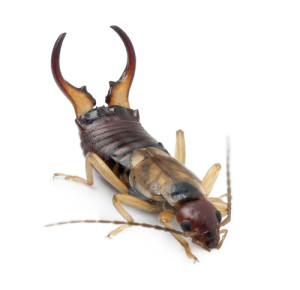Look out Fox Valley! Earwigs are coming! Earwigs are coming! If you’re not careful, they
may crawl into your ear and burrow into your brain!
Although the name “earwig” is loosely translated to mean “ear creature” this untruth stems
from a several centuries long superstition that this arthropod will crawl into the ear of a sleeping
person. Once there, it was believed the female earwig would bore into the brain and lay
her eggs there. Before you knew it, you would have a family of earwigs crawling inside your
head driving you crazy. Fortunately this is fallacy, but earwigs can still become a problematic
nuisance pest.
This year we took a lot of moisture late in the winter. This continued throughout the spring and
early summer. That led to very damp soil conditions and moist mulch areas around the home
early in the year. We have noticed a large up-tick in the earwig populations due to this and other
factors, such as the high humidity this summer. All of these things contribute to the huge earwig
populations we are experiencing now.
Earwigs generally live on the exterior of your home, seeking any dark, moist crevice, such as
vegetation and wood piles.
Earwigs are active at night and hide during the day in cracks and crevices. They are mainly
scavengers and occasionally feed on plants. The eggs are laid in burrows in the ground and most
species overwinter as adults.
During times of heavy population (like this year) earwigs turn to our homes. When earwigs
do invade homes, they can get into everything, including laundry, furniture, loaves of bread,
and even clothing and bedding. They hide in cracks and crevices throughout the home and are
difficult to keep out, even with the use of screens and other barriers.
A homeowner has 2 main courses of action when dealing with this nuisance pest. Neither work
in isolation, rather both works in tandem to provide the best results.
1. Clean up surrounding areas – Earwigs can be found in large numbers under boards,
in tree holes, under decaying bark, or wherever it is moist and dark. The first step
to controlling earwigs is to eliminate these and other breeding and nesting places.
Homeowners should remove decaying vegetable matter around the home, such as piles
of leaves or grass clippings. They should also repair poorly placed rain downspouts and
broken irrigation systems, which contribute to moist, dark areas that are attractive to
nesting females.
2. Exterior perimeter sprays – Professional pest control products may be used to control
earwigs. However, most spraying should be done outside the house to provide a barrier
over which earwigs will be less likely to cross. Active ingredients such as deltamethrin,
cyfluthrin, fipronil, lambda-cyhalothrin, cypermethrin, sumithrin or tralomethrin may be
used in such perimeter areas and must be applied according to label directions. Outdoor
perimeter spraying should be started during early summer and continue through late
fall. Special attention should be paid to the areas most frequented by earwigs, including
building foundations, areas along fences and walks, around trees and utility poles, and
around wood piles and rocks.
In order to really optimize control of damp-dwelling earwigs and other mid-summer pests
like centipedes & millipedes, homeowners need to apply a perimeter barrier of about 3 feet in
width, extending around the entire exterior of their home. This barrier should be applied in two
concurrent months, and then once every season thereafter during the spring, summer, and fall.
Additional treatments should be provided as needed. An ambitious homeowner may undertake
this task on their own, or contact a trusted professional, like ProActive Pest Management.
If you have any questions about earwigs or any other pests, please do not hesitate to call. We are
here to serve.

